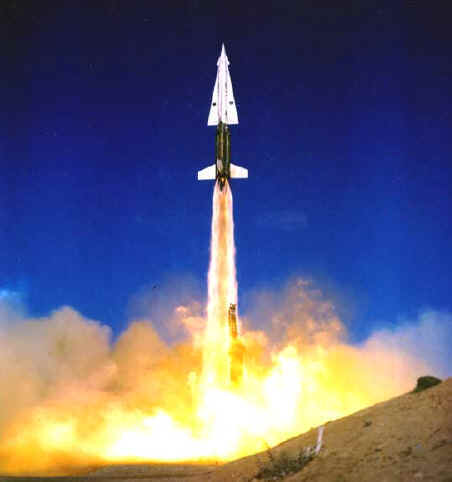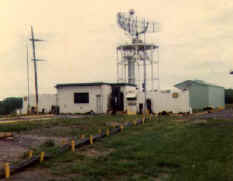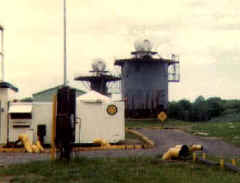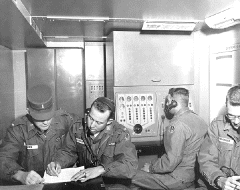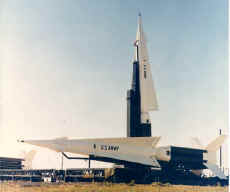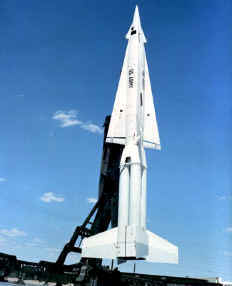Life at a Cold War Nike Missile Site
THREE HOURS FROM ARMAGEDDON |
|
||||||||||||||
| Author’s
Note. For those of you too young to know,
"Nike" wasn’t always the name of a shoe.
Nike, named for the Greek goddess of victory, was a
family of air defense missiles that protected this nation
for 20 years of the Cold War. This year is the 45th
anniversary of the activation of the first Nike missile
site in the United States and the 25th anniversary of the
deactivation of the last. I was a Nike system crewman for
three years at a site on Campgaw Mountain in Franklin
Lakes, New Jersey. The story of the Nike sites in the
United States is unique in that these tiny installations
played such a vital role in the nation’s defense
against nuclear attack and were manned by regular Army
soldiers and Army National Guardsman who often lived in,
and were sometimes raised in or near, the communities
they defended. I’ve set down my recollections as
accurately as my 34 year old memory will allow and, I
hope, in a way that will be of some interest. In the end
though, it’s just my story: a soldier’s story. Beginnings "Sleek, supersonic missiles guided by the most modern radar and manned by combat-ready crews around the clock," he said. "And, you can have your pick of one of many geographic locations around the country and be guaranteed a 14-month assignment there. You’ll be trained on-the-job by your unit’s sergeants at the actual site where you’ll work." I had to admit that the photos in the brochures he showed me made it look like glamorous stuff. (H’mm. I do have a steady girlfriend in Pompton Lakes.) "What d’ya have around here?", I asked. Following basic combat training at Fort Dix, New Jersey, I reported to Battery B, 5th Missile Battalion (Nike-Hercules), 7th Artillery in Franklin Lakes, New Jersey. That was the designation of the Army unit that manned the site. In some Army Corps of Engineers installation listing it was Nike Site NY 93/94. I was to learn that our AADCP (Army Air Defense Command Post) referred to us, tactically, as "Site Seven Five". That’s just the Army for you. It all meant the same place at the top of Campgaw Mountain, and it was to be my home for at least 14 months.
New Home, New Friends I was assigned to Staff Sergeant Curtis Davidson’s crew for training as a Fire Control Operator. "What d’ya mean "fire control? "I thought I was gonna operate radars!" In military parlance, "fire control" has nothing to do with extinguishing blazes and everything to do with controlling the firing of weapons. Thus, the IFC (Integrated Fire Control) Area "integrated" the functioning of the surveillance (or "acquisition") radars, a fire control computer, and two tracking and one ranging (or "fire control") radars used in guiding the Nike-Hercules missiles to their targets. Sergeant Davidson’s barracks was one of several temporary metal buildings. The passage of time proved, however, that it was "temporary" only in terms of the "T" designator painted on its outside wall. These buildings were one-story structures set on concrete slabs with a tile floor, a door at each end, and windows down the sides. Single bunk beds, with a footlocker at the foot of each bunk, lined each side of the long inside walls. Personal wall lockers lined the rear wall and the front end of this open bay area. At the very front of the building, two small rooms were walled off from the bay, one on either side of the building. The four most senior men living in the building had these rooms. However minor the privilege, RHIP (Rank Hath Its Privileges) prevailed. Bathroom facilities (the "latrine") were in a permanent cinder block building a short distance from the barracks. The first time I had to dash to the latrine down an icy sidewalk at 3 a.m. in my boots and skivvies, I learned that drinking too many beers on a frigid winter night wasn’t a smart thing to do.
I soon developed a friendship with two fellow crewmen: Privates Joe Farnum and Jim Lance. Farnum and Lance were already good friends and were developing into a close knit tactical duo as well, with Joe as the crew’s Acquisition Radar operator and Jim as a TTR (Target Tracking Radar) operator. The two positions are analogous to a baseball team’s pitcher-catcher combination. Joe was from Manchester Depot, Vermont, and Jim was a draftee from Eau Gallie, Florida: a Yankee and a Southerner. Most people couldn’t quite get a handle on Jim’s personality, because although he had been drafted away from his civilian profession as a grocer, he applied himself to his military work with earnestness and enthusiasm. We finally talked about it one night over some beers. "Now you gotta understan’, I ain’t no "lifer" like some’s been sayin’. When my two years is up, I mean to go home. But I figure that seein’ as how I was drafted, I coulda’ just as easy been sent to Vietnam as here. I was just plain lucky. So, I’m gonna do the best job I know how ‘long’s I’m here. ‘Sides, if the worst thing I gotta’ put up with is you Yankees fer awhile, I guess I can handle that awright." True to his word, Jim went home to Florida in 1967. Also true to his word, and long before he left, he was a qualified operator at each of the five positions in the RC (Radar Control) van, and a master of the three TTR positions. When Jim went home he took with him our good wishes and something else: a new "Yankee" bride.
The Devil is in the Details Although armed with a .30-caliber carbine and live ammunition, gate guard was primarily an entrance control measure. Our IFC Area fenced perimeter, which at one time had accommodated two, separated IFC Areas, was large. The area was rolling terrain perhaps a mile deep and a quarter of a mile wide. There simply weren’t enough people in the IFC Platoon to secure the entire perimeter, and we were, after all, in New Jersey; not overseas. The fact of the matter was, if a saboteur or team of saboteurs had wanted to put the site out of action for a period of time, they could have fired into the radars and BC and RC vans with telescopically-sighted high-powered rifles at some distance from the perimeter fence. A set guard was present in the BC van at any time that other personnel weren’t present. Since the equipment remained in a "power on" condition continuously, part of his function was to act as a fire guard. The set guard also monitored the voice communications line with the AADCP and would be the person notified if a change in the battery’s alert status was ordered and the one to sound the BC van siren, starting the process of bringing the battery to battle stations. Physical security in the battery’s Launching Area was a different story, altogether. The Launching Area was located about a mile from the IFC as the crow flies, farther by road. The geographical separation almost made it seem like a separate unit, and we in the IFC seldom saw missile crewmen, except at meals. The Launching Area was physically much smaller than the IFC and heavily guarded by missile crewmen and a contingent of Military Police, with police dogs. It was further subdivided into smaller fenced and alarmed areas of increasing physical security known as the Limited Area and the Exclusion Area. The missiles were stored in underground magazines and Launching Area security was specifically designed so that no intruder could get to those missiles or warheads. KP duty was basically a combination dishwasher and busboy function in the battery’s mess hall. It was not a punishment, but a rotating duty among junior ranked soldiers in the battery. It started at about 3:30 a.m. and ended that evening whenever the mess steward said you could leave, but usually not before 7:00 or 8:00 P.M. Three KPs were assigned to the mess steward each day and their routine responsibilities were divided between keeping the dining room cleaned and the tables stocked with napkins and condiments; washing pots, pans, and other cooking utensils; and washing trays, cups, and flatware. Non-routine duties consisted of whatever the mess steward and cooks said they were, and those jobs could be anything from scrubbing cooking surfaces to cleaning out filthy grease traps. Cooks, regardless of rank, had pretty much no influence or power over anyone in the battery unless you were on KP. So, I tried my best to stay on the good side of the battery’s cooks (and out of the grease traps). In today’s Army, soldiers no longer perform KP.duty and, for the record, mess halls are now called "dining facilities." How nice! As I noted before, the IFC area was maybe a mile deep by a quarter of a mile wide and, with the exception of a few structures and some asphalt, it was all in grass. Some of the National Guard sites that I had visited had farm-sized tractors with mowers for grass cutting. I guess the State of New Jersey provided them for those sites, because our Regular Army site had no such machines. We had a few gasoline engine-powered mowers (for the cutting blade, only), a few completely manual mowers, long-handled swing blades, and manual edgers. During the summer months, keeping up with the grass was never-ending, hot, and dirty.
The Life of a Missileman At the battery level, alert status governed our daily lives. We lived as though we were never more than three hours from war and possible Armageddon. Our normal schedule was one week of the month on 20-minute ("A") status, one week of the month on one-hour (M-1) status, and two weeks of the month on 3-hour (M-3) status. A one-hour status battery was a "back-up" to a 20-minute status battery, should that battery go out of action for any reason. This resulted in our frequently pulling more than the scheduled one week per month of 20-minute status. I think it was during my last year at the battery that a routine inspection of missile rocket motors in the defense revealed cracks in the solid propellant of many of the missile motors, taking several batteries out of action until replacement motors could be delivered. Our battery’s missiles didn’t have this problem and we ended up on continuous 20-minute status for more than 100 consecutive days. Those who didn’t live in the barracks or the military housing just outside the Launching Area simply packed bags and moved onto the site for the three plus months and, yes, the guard duty, KP, grass cutting, etc., continued as always. Two IFC crews were authorized in the battery, so when the battery was on 20-minute status, the two crews would alternate being on-site, 24 hours "on" and 24 hours "off." If your crew was the one on duty or if you were on guard duty, you didn’t leave the IFC Area, period. Much of our training occurred on 20-minute status, since we had to be there all day and all night anyway. Regardless of alert status, you had to be able to be reached by phone when you were off duty. An overnight pass was issued at the end of the duty day with a short mileage limitation, based on the battery’s alert status. You signed out in a "pass book," leaving an address and telephone number where you could be reached. If you decided to go somewhere else later, you had to call the battery and give the same information for the new destination. I can’t even guess at how many times I was called back to the site while on pass. On one occasion in a movie theater, the feature was stopped to page me to return to the site. A
Soldier Does Well That Which The Commander Inspects Passing inspections and evaluations resulted in little more than a "pat on the back." Failure, however, resulted in a "kick in the pants" and the privilege of repeating the inspection or evaluation until it was passed. Some years after I left the site, an officer told me that he had often seen commanders relieved of their command for lousy maintenance, but seldom for poor tactics. Obviously, he had never served in Nike. An officer could be a Nike battery commander today and find himself in some "end of career" assignment tomorrow, all because a "simulated" enemy aircraft penetrated his battery’s area of responsibility during an important tactical evaluation. That sounds harsh, but the number of lives lost due to a bad decision or moment’s inattention in actual combat would be horrendously high. We weren’t in combat, but we were in a pressure cooker. Battle
Stations It probably was an accident; a mistake or series of them that started it all. Czechoslovakia had become too liberal, too western for the Soviets to continue to ignore. After weeks of warnings from Moscow, the Red Army had finally invaded in a crackdown on the tiny country. Fighting with the resisting Czech military had briefly spilled across the border into West Germany. Just that quickly, U.S. and German troops found themselves in combat against Russian soldiers. The Soviet government accused the West of attempting to fracture the Warsaw Pact by aiding the Czechs. The U.S. government accused the Soviets of taking advantage of our being heavily engaged in Vietnam by making a land grab for West German territory. Neither accusation was, in fact, true. Whether due to paranoia or political posturing, the actions of both governments were like throwing gasoline on a fire and the fighting continued with mounting casualties to both sides. Now, reinforcing troops were being flown from U.S. east coast air bases to Germany and cargo ships in east coast ports were being loaded with war supplies. As a result, both these air bases and ports had become possible targets for air attack. That’s how I got to be where I am now. We, and the rest of the New York-Philadelphia Defense are on 20-minute ("Hot") alert status, air defense warning "Yellow", and weapons control order "Hold.." It means that an air attack is likely, but that we can only fire in "self-defense." This ensures that the New York and New Jersey Air National Guard jet interceptors will get first crack at any attackers without accidentally being targeted by our Nike missiles. Soviet TU-95 "Bear" bombers, equipped with electronic "listening" gear, have been flying off the east coast at various times this past week. At some 200 miles out, the Soviet government says the aircraft are exercising their "right to navigate in international airspace". What they are really doing is gathering electronic information about our air defense systems. This has occurred often in the past, but the timing now is worrisome. Our interceptors have been shadowing them; exercising our own "right to navigate in international airspace." It’s 1 A.M., and we’ve just finished the equipment checks and adjustments that we perform every six hours when we’re on "Hot" status. The squawk box on the rear wall of the BC van suddenly blares, "Natty Brute, this is Draft Taboo. Air Defense Warning Red, Weapons Hold, Battle Stations, Case 3. Acknowledge in site number order." I’ve heard the AADCP broadcast a similar message in exercise terminology hundreds of times: "Big Noise, Apple Jack, Delta, Blazing Skies, Case Zulu." The shock of now hearing the real words is punctuated by a sick cramping in my gut. The BCO (Battery Control Officer) repeats the call to battle stations over the battery’s tactical intercom. Farnum, the acquisition radar operator, is seated to the BCO’s left, and he hits the BC van siren out of force of habit. No need; we’re all here. The crew drill is an intricate modern dance of memorized last-minute checks and adjustments performed in cramped spaces in both the IFC and Launching Areas. We have 15 minutes to complete it and report "Ready for Action" to the BCO. We’ll then be at five-minute status. "LOPAR & ABAR, ready for action." "Computer, ready for action.""MTR, ready for action." The reports continue to stream in and the battery is finally at five-minute status. The BCO moves a switch and status lights in the BC van, RC van, and Launching Area change from blue to red and an electronic warning bell sounds. The MTR (Missile Tracking Radar) is locked on our first missile’s beacon signal. The BCO reports to the AADCP, "Site Seven Five is at battle stations." Farnum’s radar scope is filled with jamming signals. Those TU-95s are out of missile range and trying to blind us with interference. Apparently, they’re equipped to do more than just spy. Farnum fights the jamming for a minute or less and switches to the higher-powered, longer-range ABAR (Alternate Battery Acquisition Radar), which operates in a different frequency band. The scope picture is clearer, though not completely free of jamming. We see what must be interceptors streaking outbound "faster’n the speed of smell" and finally disappearing past the ABAR’s display range. Suddenly, the radar jamming stops completely. The EWPB (Early Warning Plotting Board) operator is calling out and plotting friendly inbound track reports from the AADCP and they soon appear on Farnum’s scope, heading toward the coast. It’s a different group of interceptors; landing. They must’ve gotten the TU-95s. Several minutes pass. The squawk box erupts again. "Natty Brute, this is Draft Taboo. Weapons Tight. Acknowledge in site number order." We can now fire at anything positively identified as hostile, so something hostile must still be heading inbound. The EWPB operator is again calling out and plotting friendly inbound tracks. The radar returns from these soon appear on Farnum’s scope, surrounded by electronic "friend" symbols generated by the AADCP. Although the friend symbols remain, the radar returns disappear off the scope at more than 100 miles from the coast. They’ve descended to very low altitude, and there’s only one reason why fighter pilots already low on fuel would do this: they’re getting out of our way. The EWPB operator starts calling out and plotting hostile inbound tracks. At least two dozen inbound targets, spread out in groups of two’s and four’s, are heading toward the coast. An AADCP-generated "foe" symbol is around each radar return on the scope. One of these symbols indicates that our battery is to engage that target. The aircraft is still about 80 miles past the TTR’s maximum range, and it will take it about eight minutes to close that distance. Silence now, except for the 400-cycle whine of the equipment. Darkness, too. In the subdued light of the vans, it’s always night. Time to think ... too much time to think. The AADCP called us to battle stations in Case 3. That means that we can only fire missiles containing high explosive warheads. The president hasn’t issued a nuclear weapons release. Apparently, he’s not going to be the first to open that Pandora’s Box, even in or near our own airspace. I can only hope that none of the attackers are carrying nuclear bombs ... and that none of them will get through us. O.K., concentrate on the job. What should go right? What’s likely to go wrong? When the target gets close to the TTR’s maximum range, the BCO will command "Designate." Farnum will position a steerable azimuth/range video dot over the target return and toggle a switch. He’ll continue to manually track the target in azimuth and range until the TTR reports "Track." The three TTR operators in the RC van will work as a team to get the target tracked by the TTR. After the target is designated, the TTR azimuth operator will hold the "Acquire" switch until the TTR has slewed to the designated azimuth and range. He’ll then command "Search," and the elevation operator will cause the TTR antenna to move in elevation until a triangular-shaped video pulse, representing the target, appears on the three operators’ radar scopes. The range operator will move an electronic range "gate" across the scopes to the target pulse and announce "Target in the gate." If no jamming is present, all three operators will turn switches to "automatic" tracking mode, and the TTR will automatically track the target. The azimuth operator will then press a switch, both to indicate in the BC van that the target is being tracked, and to electronically release tracking data to the computer. The entire process from "Designate" to "Track" should take no more than 10 seconds; and a lot less with a good crew. The computer, now receiving both MTR and TTR tracking data, will cause automatic "Horizontal" and "Altitude" plotting boards in the BC van to display target position in azimuth, range, and altitude; and a predicted intercept point and time to intercept if the missile is launched now. This information will be continuously updated until the missile is launched. Once the missile is launched, the plotting board stylus indicating predicted intercept point will move to indicate the missile’s flight path to the intercept point. By constantly comparing missile and target tracking data after launch, the computer will issue steering commands to the missile via the MTR, and a "burst" command at the appropriate time. The missile warhead will then detonate, hopefully, destroying the target. O.K., what’s likely to go wrong? "Farnum, take that overlay off the scope ‘til we need it. It’s hard to see some of the video with it there." The BCO’s remark answers my question. The overlay is made of clear acetate, cut to fit the circular scope. On it, are drawn "safe passage corridors" and other information to aid us in discriminating between hostile and friendly aircraft. The AADCP is performing the identification and target assignment functions for us now, but if we lose electronic symbology and voice communications with the AADCP, we’re on our own. We call it "Autonomous Operations." If we have to "go autonomous" we’ll primarily be responsible for defending a preassigned pie-shaped sector of sky, centered on an imaginary "primary target line" or PTL. We’ll use both electronic identification equipment and procedures known as "rules of engagement" to decide whether a target is friendly or hostile and whether or not to engage it. The overlay that the BCO referred to will be used as part of this process. Too often, the final decision to be taken by the young, underpaid officer filling the BCO position will not be obvious. Is the aircraft that is moving in and out of the safe passage corridor, not responding to electronic interrogation, sometimes at authorized speeds and altitudes and sometimes not, a hostile? Or is it a friend that is shot up and trying desperately just to stay in the air and near to where he’s supposed to be? An erroneous decision either way will result in death to thousands of people on the ground or to a friendly air crew in the sky. "Designate." The command jolts me back from my thoughts. "Acquire". "Search." Farnum’s impatiently tapping his foot. "Target in the gate."."Track."I hear Farnum disgustedly mumble, "Damn near 10 seconds to get a track an’ our best TTR operator’s home in Florida sellin’ groceries. I sure’s hell wish Lance was over there on the TTR." The BCO shoots him a hard look that says "Can it." The computer has given us a "Ready to Fire" light. The BCO’s taking another one of those hard decisions. He’s letting the target get close enough so that it can’t possibly turn away and escape the missile, without letting it get so close that it will be able to release its weapons prior to the missile intercept. "About to engage. 5, 4, 3, 2, 1, FIRE.". Within two seconds a "Missile Away" light illuminates in front of me. The plotting boards are depicting both the missile and target flight paths, and the time to intercept begins to clock down. We feel a slight vibration and hear a muffled sound like distant thunder; effects of the missile launch delayed by distance. The BCO electronically sends the next missile request to the Launching Area. The missile left its launcher under a combined thrust of 186,000 pounds from its four rocket motor boosters. The booster cluster burned out and separated from the missile about four seconds after launch. The missile’s sustainer motor has fired and, it too, will burn out in about 30 more seconds. Missile speed will top out at more than 2,500 miles per hour. Now the TTR reports jamming from the target. The three operators take the radar out of automatic mode and manually control the radar’s tracking. The jamming signal itself can be tracked in azimuth and elevation, but the jamming obscures target range information. Unless the computer has constant target range data, the missile won’t intercept the target. The tracking supervisor commands the range operator to select TRR range data. The TRR (Target Ranging Radar), slaved to the TTR in azimuth and elevation, operates in a different frequency band from the TTR and has two independent transmitters that can be alternately selected. This quick action saves the engagement. The tracking supervisor will now operate the two TRR transmitters to keep target range data flowing to the computer. Although the missile’s sustainer motor has burned out by now ,and the missile is "coasting," it will still be traveling at about 2,000 miles per hour as it descends to the intercept point. BCO: "What’s the time to burst?" Meanwhile, aboard a Soviet MA-4/201 "Bison" bomber, the radio electronic combat officer scans his displays. "No missile launch or guidance signals evident. I’m continuing to work countermeasures against the X-band and two K-band transmitters attempting to illuminate us." "Pilot to crew. Take stations for the bomb run. Bomb run I.P. in 30 sec ..." An explosion takes time to develop; only thousandths of a second, to be sure, but time nonetheless. The missile warhead began its detonation about 30 feet in front and slightly above the nose of the bomber. In the time that the aircraft closed this distance, the blast had developed to its full effect and was tearing the bomber into unflyable scrap. I’m watching the Target Speed indicator on my console. "Target speed dropping to zero." Now, from the TTR azimuth operator, "Target breaking up in the gate. Target destroyed." The tactical intercom is filled with the sound of cheering crewmen. "O.K., O.K., quiet! This isn’t over yet." The BCO points to a target on Farnum’s scope. "Designate."
A Soldier's Perspective We’ve found in the years since, however, that making nuclear war unthinkable has not made war, itself, unthinkable. Wars, using conventional weapons, have continued unabated. The long range strategic bomber remains an effective weapon of conventional warfare. With in-flight refueling, no place on earth is beyond its reach. The U.S. Air Force has proved this time and again, and as recently as this year. I believe that the continental U.S. was more, not less, vulnerable to conventional air attack from ARADCOM’s deactivation in 1974 until the final breakup of the Soviet Union. The fact that it never happened is largely attributable to luck: luck that a triggering crisis of sufficient magnitude never occurred. Endings In 1987, on a family vacation to Florida, I attempted to locate Jim Lance. It had been 20 years since he had left the battery. On a long shot, I called the information operator and, to my surprise, located him right away. We met at his home and had a wonderful evening remembering people and recalling events from our service together. For me, the character of Jim’s two years of active service will always epitomize the concept of the "citizen-soldier." Leadership is a frequent topic in military journals. Good leadership, however, is extremely difficult to describe, except anecdotally. You just know it when you see it, and we troops saw it every day in Captain Jay M. Garner. He was my last battery commander at the site and my best commander at any level, anywhere. Several years later, he and I served together again in the 101st Airborne Division (Air Assault). Our paths crossed several more times over many years, but always too briefly for me. He has served in two wars, and been a tireless advocate of the Army’s continuing role in air and missile defense. I was most proud of him when he led American soldiers in protecting and sheltering the Kurdish people of northern Iraq, following the Gulf War. But beyond all that, I and many of his former troops appreciate him for the positive influence he has been in our lives. Lieutenant General Jay Garner retired from active service about two years ago. He is the finest officer and soldier I’ve ever known. A line from a Jimmy Buffett song goes, "If I could just get it on paper, I might make some sense of it all." I hope I’ve done that here. We ARADCOM soldiers were your neighbors; albeit ones who kept odd hours. Weekdays, weekends, holidays, everyday; we worked to protect a vital national interest far more precious than oil or any number of small countries halfway around the world: you, our good neighbors.
|
|||||||||||||||
| Gary Stephens is a retired U.S. Army Chief Warrant Officer, now employed by the Southern Research Institute in Birmingham, Alabama. He and his family reside in Madison, Alabama. Mr. Stephens welcomes comments and questions. His email address is zzstephens2@hotmail.com | |||||||||||||||
Source
This excellent article used to be located at: Source. That server seems to have vanished, it would be a shame to lose
this valuble bit of history, so I've retained it here.
